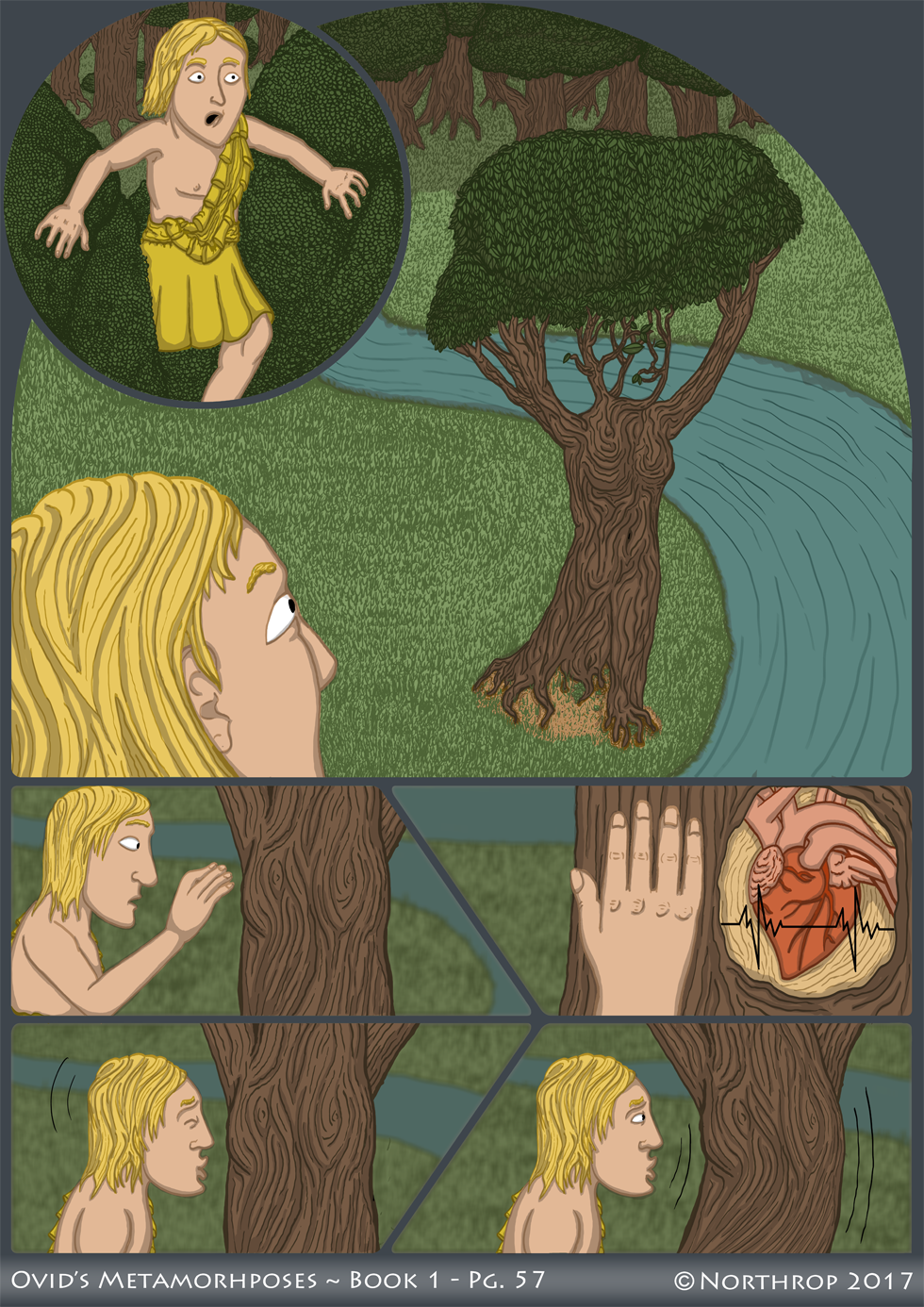Met. 1.553-59 – Apollo Loves a Tree
sentit adhuc trepidare novo sub cortice pectus,
complexusque suis ramos, ut membra, lacertis
oscula dat ligno; refugit tamen oscula lignum.
This too Phoebus [Apollo] loves, and with his right hand placed on the trunk
he feel her heart beat beneath its new bark,
and wrapping his arms around the branches, as if they were human limbs,
he kisses the wood; nevertheless, the wood recoils from his kisses.
(Met. 1.553-59)
Oh hey – yeah, as usual, it’s been a while. I am juggling a lot of things right now, trying to get a job with my fancy new degree. I work on the comic whenever possible, though, and I won’t leave you hanging forever: I promise!
It strikes me that this page is based off fewer lines than the previous one, although this page has more panels. I do try to keep the complexity of the page
commensurate with the length of the excerpt. Still, sometimes you have to take into account the effect complexity has on comic pages: fewer panels makes a page more striking, and I wanted the last page, with Daphne’s transformation, to be particularly eye-catching. Ovid lingers over the description of her transformation, but actually spends little time on her tree-form. I assume that he assumes his reader should be able to picture a laurel tree. I have seen a few in my time, but I’ve always found them to be somewhat ugly (check out the pic on the right and decide for yourself ->). I decided to freely interpret the shape of the tree (so I could make it look humanoid), and just draw the laurel’s distinctive leaves (bay leaves, the same ones you cook with). I hope it won’t offend the botanically-minded amongst you.
Ovid says little about Daphne’s tree-f0rm. He is a poet often more concerned with actions than descriptions. Apollo’s action are weird (he’s been pretty creepy throughout this story), and he seems to try to seduce the tree. Weirder still, Tree-Daphne seems to be able to move, at least somewhat. Who can say whether this is an effect of being newly transformed (her heart is still beating after all), or if Apollo is simply imagining these things? It might really be happening here, but the next time Tree-Daphne moves (Met. 566-7; next page…) she only seems to be moving intentionally, Ovid says. My guess is that Ovid puts that little bit of ambiguity in there to tease the reader about the nature of metamorphosis: is it real, or imaginary? Is it a façade merely covering the original form, or is it a true transformation into something entirely new? I believe that this is a question that Ovid wants us to keep asking ourselves as we journey deeper into his fantastical world. Be ready to question everything, even your own perception of reality.
Also, I realise now that I totally forgot about Apollo hugging the tree when he tries to kiss it. Sorry! I might change it at one point, although I think the way I’ve depicted it looks nicer in the comic format….


I like the way you showed the beating heart
I’m italian, and i know this story since i was as young as Amor (who’s barely bearded, like the passions he lights up). Let me please correct slightly your translation. Ovidius’ latin is so greatly simple:
«Her, too, Phoebus loves [the tree: in latin, trees have masculine endings, but feminine pronouns and adjectives, like the word “hand”; which results in a strange effect of feminine strength that i cannot convey]; and, placed on the trunk the right hand, feels at this point a heart beat beneath its new hard cover [=bark]; and with his arms wrapped around the branches… [etc.].
Thanks for attention.
I’m italian, and i know this story since i was as young as Amor (who’s barely bearded, like the passions he lights up). Let me please correct slightly your translation. Ovidius’ latin is so greatly simple:
«That her, too, Phoebus loves [meaning the tree: in latin, trees have masculine endings, but feminine pronouns and adjectives, like the word “hand”; which results in a strange effect of feminine strength that i cannot convey]; and, placed on the trunk the right hand, feels at this point a heart beat beneath its new hard cover [=bark]; and with his arms wrapped around the branches… [etc.].
Thanks for attention.
eeeee